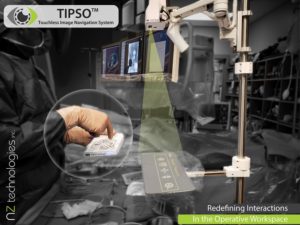 A recent publication confirms “the utility of touchless image navigation in the sterile field in facilitating decision-making and resource allocation during endovascular procedures.” The study, published in Minimally Invasive Therapy & Allied Technologies, provides the third clinical review of TIPSO technology (NZ Technologies), a human-computer interaction based platform that allows real-time access to imaging data in the sterile field.
A recent publication confirms “the utility of touchless image navigation in the sterile field in facilitating decision-making and resource allocation during endovascular procedures.” The study, published in Minimally Invasive Therapy & Allied Technologies, provides the third clinical review of TIPSO technology (NZ Technologies), a human-computer interaction based platform that allows real-time access to imaging data in the sterile field.
Lead author Behrang Homayoon (Department of Radiology, Surrey Memorial Hospital, Surrey, Canada) contextualises what he sees as the clinical need for this technology, writing: “The inability to have comprehensive access to all pertinent imaging data related to an endovascular procedure in the sterile field is an unmet need, and its absence may have deleterious effects on decision-making, outcomes and workflow. Current image navigation solutions rely on traditional personal computing interfaces which are difficult to use in the sterile field. Innovative technological solutions are needed to address this need.”
In Homayoon et al’s study, the investigators conducted a case-based observational review of the TIPSO technology’s use in the endovascular suite. The study authors report findings that demonstrated the utility of the product in decision-making and resource allocation, “while avoiding the cognitive and workflow disturbances inherent in leaving the sterile field or involving non-scrubbed third persons in the image navigation process.”
They conclude: “Physician engagement and ‘needs-based’ technological innovation is needed to improve human-computer interaction in the endovascular suite, in hopes of positively affecting procedural decision-making, outcomes, and workflow.”
TIPSO technology
According to an NZ Technologies press release, the touchless control capability of TIPSO is enabled by a unique bedside interface designed for touchless interaction with patient images, obviating the need to delegate the task to an assistant, or un-scrub and use an imaging workstation outside the sterile space.
Homayoon comments: “Our study shows that TIPSO significantly improves physician interaction with—and access to—medical images, providing an impressive enhancement to procedures conducted in the endovascular suite. With safety and efficiency in mind, the use of TIPSO contributes to the adoption of best practices, and improves the quality of patient care and outcomes.”
This latest paper joins two others that present the results of an evaluation of the technology in a range of cases. Collectively, the three reports found that the TIPSO technology contributes by improving workflow in a number of different medical procedures by minimising the episodes of scrubbing-out for image review outside the angio suite, thereby reducing overall procedural time. The articles also reported a reduced use of contrast agent, lowered radiation exposure, and increased procedural precision—all advantages that support better patient outcomes.
Future wireless–touchless applications under NZ Technologies
With an increasing amount of equipment and tools in the operating room that require precision control, the future operating room warrants a centralized technology platform that enables on-demand interaction and automation, all while minimizing the clinician’s burden and effort. This would include such routine tasks as raising or lowering the operating bed height, adjusting room light levels, controlling robotics, and managing gas levels. According to Nima Ziraknejad, founder and CEO of NZ Technologies: “We are driven by our vision to revolutionise the way in which clinicians interact with their operative environments. TIPSO is just the beginning of our development of technologies for the operating room of tomorrow, all aimed at delivering automated, touchless control as the standard of care.”
David Liu, (Department of Radiology, University of British Columbia; Vancouver General Hospital, Vancouver, Canada), was senior author of two of the recent TIPSO studies. He explains, “The modern operating theatre has many distractions arising from simultaneous data, imaging and clinical feeds that can affect the concentration of the surgeon or operator, especially while performing technically or mentally demanding manoeuvres. TIPSO helps usher in a new era in which, as operators, we are taking back our mental bandwidth and allowing clinicians to focus on the important work at hand: saving lives and improving the health of patients.”











